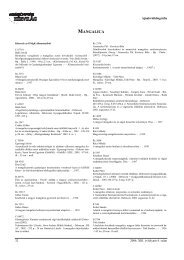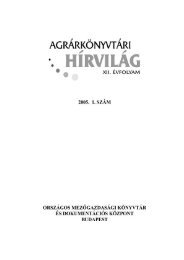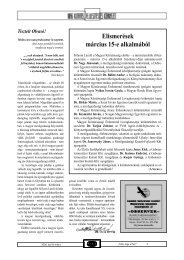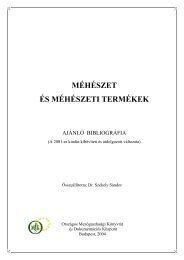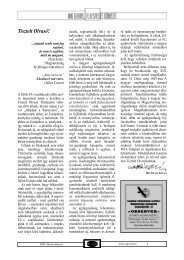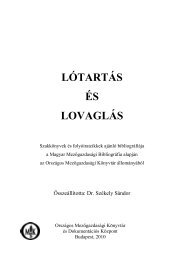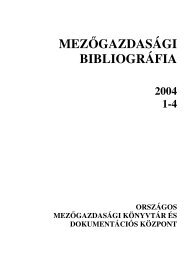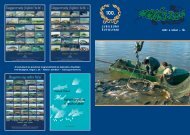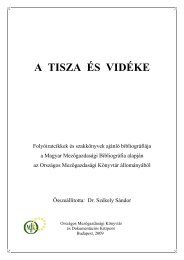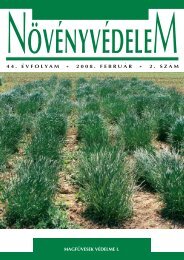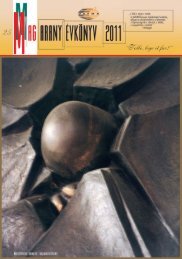hUNGARiAN AGRicUltURAl RESEARch
hUNGARiAN AGRicUltURAl RESEARch
hUNGARiAN AGRicUltURAl RESEARch
Create successful ePaper yourself
Turn your PDF publications into a flip-book with our unique Google optimized e-Paper software.
ARIMA model to make forecasts:<br />
identification, estimation, diagnostics<br />
(Ramanathan, 2002).<br />
Bass (1969) diffusion model –<br />
providing excellent long term<br />
forecasts even on few data - is<br />
usually used for forecasting the<br />
spread of new products in<br />
marketing science to compare<br />
diffusion processes even on<br />
international platform. Difficulties<br />
occur in Bass-model fitting if the<br />
growth process is very slow.<br />
The short term forecasting<br />
ARIMA models are new in<br />
modelling the diffusion process of<br />
new products since TS forecast<br />
techniques spread through the great<br />
counting capacities of the personal<br />
computers in the last decade. Box<br />
and Jenkins propounded at least<br />
50 observations for performing<br />
TS analysis e.g. ARIMA.<br />
(Ramanathan, 2002).<br />
Results of Bass and ARIMA<br />
models<br />
Among other researches<br />
applying Bass model, Talkudar<br />
(2002) analyze the Bass parameters<br />
and the potential market size across<br />
countries by assembling a novel<br />
dataset that captures the diffusion<br />
of 6 products in 31 developed and<br />
developing countries from Europe,<br />
Asia, and North and South<br />
America. The average parameters<br />
for coefficients for external and<br />
internal influence by NLLS<br />
regression method are as follows:<br />
for p: 0.0010 (developed) and<br />
0.00027 (developing) and for q:<br />
0.5090 (developed) and 0.556<br />
(developing).<br />
Hassan and Nassar (2007)<br />
analyzed datasets using time series<br />
and Bass diffusion models to<br />
forecast the spread of wireless<br />
telephone in the United States<br />
between 1984 and 1999. Their<br />
results show that AR (3) gave<br />
better forecasts than the original<br />
Bass model by the ratio of the sum<br />
of squares deviation between<br />
observed and predicted values of<br />
the models. This result is explained<br />
by the essential difference between<br />
these models as follows: How well<br />
a diffusion model predicts a given<br />
process depends on how well the<br />
assumptions are met, while time<br />
series models are empirical and<br />
flexible, they can be fit any given<br />
process.<br />
Kahn researched companies’<br />
new product forecasting practices<br />
in the USA in 2002. His survey is<br />
based on a data set of 168<br />
respondents from a cross section<br />
of industries. He found that<br />
generally the diffusion models are<br />
used by 2% of all the responding<br />
firms across all types of new<br />
product and ARMA/ARIMA<br />
models are utilised by only 1% of<br />
them. Diffusion models are used<br />
mainly at market extensions, new<br />
category entries and new-to-theworld<br />
products and sometimes at<br />
line extension. The ARMA/<br />
ARIMA models are used at costand<br />
product improvements, lineand<br />
market extensions.<br />
Benchmarking research finds<br />
that new product forecast accuracy<br />
one year after the launch is slightly<br />
above 50 percent on average –<br />
including all types of forecasting<br />
techniques (Kahn 2002).<br />
New Alcoholic Drink in Hungary<br />
The diffusion of an alcoholic<br />
drink in new, practical package was<br />
investigated in Hungary.<br />
This alcoholic drink product<br />
was a new category entry because<br />
it was a new-to-the company<br />
product and new-to the company<br />
market in spring of 2004 in<br />
Hungary, however it was not new<br />
to the general market as it<br />
previously existed on the market<br />
abroad. This product served as<br />
market extension as well, targeting<br />
new market segments.<br />
The data represented monthly<br />
sales volumes from March of 2004<br />
to March of 2008. The time series<br />
show trend and seasonal effect as<br />
well. (Figure 1.) Quarterly and<br />
yearly time series were counted<br />
from the original monthly data<br />
Alcoholic drink<br />
(BASS OLE on monthly data)<br />
sales volume [100 l]<br />
20000<br />
15000<br />
10000<br />
5000<br />
0<br />
0 20 40 60<br />
month (01. 2004 – 03. 2008)<br />
Y(T)<br />
fitted Y(t)<br />
Figure 1: Sales Volume of the Alcoholic Drink (01. 2004 – 03. 2008) and the fitted Bass Curve on Monthly<br />
Data p=0.0034, q=0.0715, m=412497 l<br />
Hungarian Agricultural Research 2009/3–4 33



